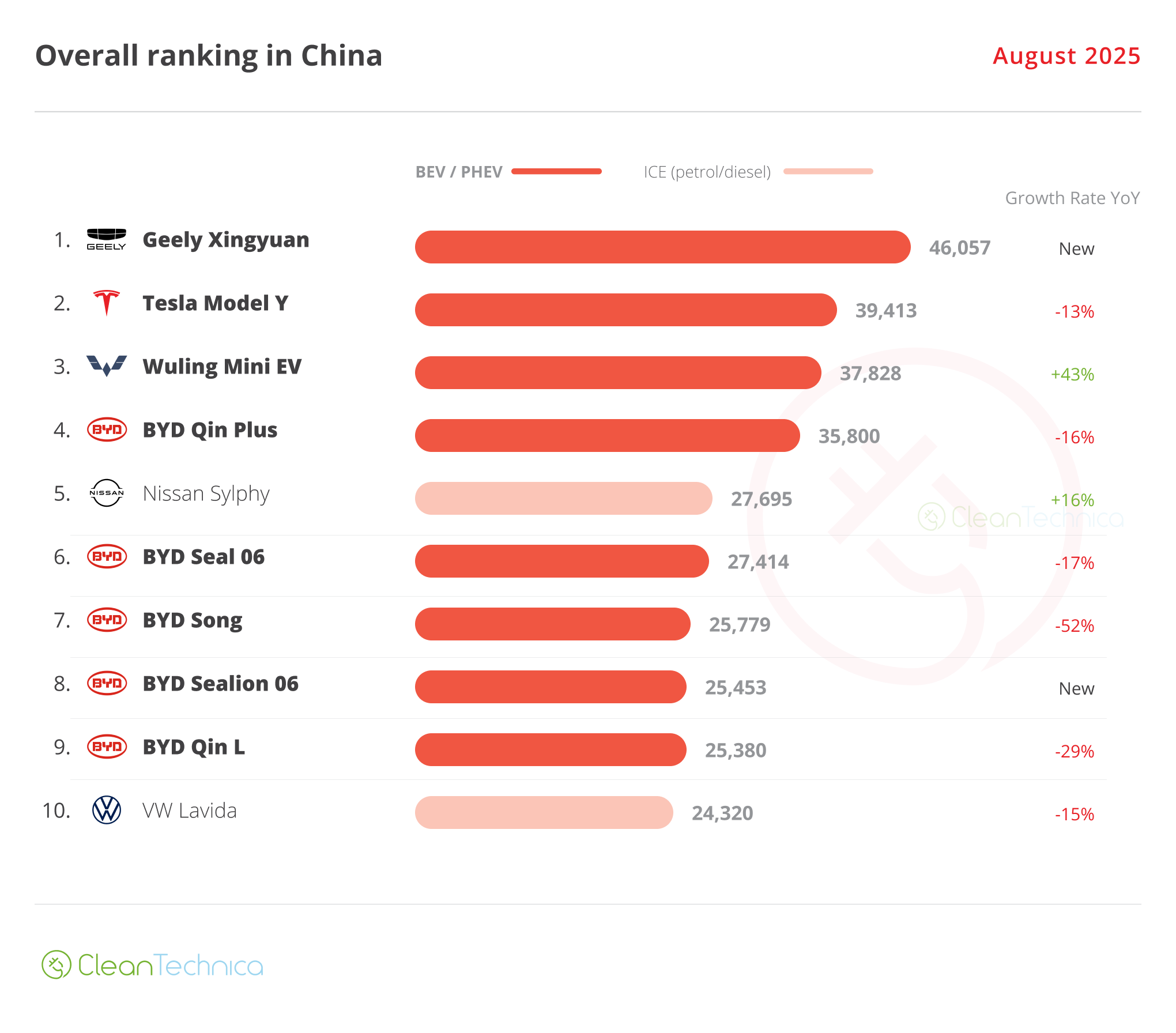Support CleanTechnica’s work through a Substack subscription or on Stripe.
Despite the coal-friendly flip in US energy policy this year, the solar power revolution is here to stay. A case in point is the iconic coal-producing Appalachian state of West Virginia, where sheep are beginning to pull double duty as solar ambassadors.
Solar Power Trickles Into West Virginia
To be clear, West Virginia’s solar journey has barely gotten off the ground. Solar advocates in the state have dreamed of transforming derelict coal mines into solar power plants since 2011, if not before, with little to show for it. In 2020, for example, West Virginia held down the #49 spot in a state-by-state ranking of installed solar capacity, with only 10.52 megawatts to its name and a five-year projection of just 154 megawatts more.
Five years later, the state has over-performed that estimate by a respectable margin, coming in at 219 megawatts as of Q2 2025. Still, that’s not even treading water in this day and age. West Virginia actually lost ground to other states. It currently hits the bottom-most ranking of #50, according to data compiled by the Solar Energy Industries Association.
That could be about to change. The global firm Enel has spotted an opportunity in Brandonville, in the northern part of the state. Plans are in the works for a 100-megawatt solar power plant that has been reportedly been fast-tracked by the West Virginia Public Service Commission.
The Real Estate Factor
Or, not. Fossil energy stakeholders have held an unusually heavy grip on state policy for generations, which helps to explain why West Virginia officials are welcoming a new $144 billion loan from the US Department of Energy, earmarked to freshen up six aging coal power plants to last up to 20 years longer.
The real estate factor also comes into play. The American Farmland Trust is among the organizations pointing out that low-density housing — aka country homes — are among the biggest threats faced by farm conservation advocates, either by replacing farmland directly or by blocking farmer access to land.
The pressure from real estate interests is evident in the Brandonville project. On November 19, the news organization Dominion Post noted that only seven letters of protest have been registered so far over the project, but at least three of them advocate for real estate development of one sort or another.
“This small slice of West Virginia paradise should be reserved for the people who want to build homes, carve out homesteads, and keep the farmlands as they’ve been for years,” reads one somewhat self-contradictory comment (emphasis added).
“It’s one of the few areas in West Virginia where there’s good, usable land and is within commuting distance of good jobs,” reads another, skipping over the farm conservation angle entirely.
Similarly, another commenter is not concerned about any kind of land conservation, stating that “flat developable land would be tied up for over 30 years.”
The Sheep Factor
Into this picture steps the emerging solar grazing industry. In contrast to housing, strip malls, industrial parks, fulfillment centers and other forms of farmland replacement, solar power plants can host farm activities while fostering nutrient replenishment in the underlying soil. Without long swaths of asphalt and other permanent infrastructure, the land within a solar power plant can be returned to full farm use after the solar panels reach the end of their lifespan.
The emerging field of scientific research and professional expertise known as agrivoltaics, or agri-solar and agri-PV, is already taking shape in the livestock industry, where sheep are a good match for solar power plants. The solar grazing movement has taken off like a rocket in Texas with Enel playing a leading role there (see more agrivoltaics background here).
No word yet on whether or not Enel plans to introduce solar grazing in the Brandonville project, but sheep are beginning to appear at other solar power plants around the state.
It’s just a drop in the bucket compared to West Virginia’s coal power profile, but one sign of progress is the Mon Power branch of the sprawling energy firm FirstEnergy Corp., which has recruited 350 sheep to trim vegetation on an 18.9-megawatt solar power plant adjacent to the Fort Martin Power Station in Maidsville.
In a press statement, First Energy VP Dan Rossero made an enthusiastic pitch for agrivoltaics. “We’re managing this site with an innovative approach that blends renewable energy and agriculture for the benefit of our community. Solar grazing allows us to keep the site operating efficiently while supporting local farmers and reducing our environmental footprint,” Rossero said.
“By partnering with sheep farmers and advancing solar power, we’re making a positive impact that extends well beyond the fence line,” he emphasized.
More Solar Power Plants, More Sheep…
Solar grazing has emerged as a way for solar developers to cut the cost of conventional mowing and other vegetation management systems, needed to keep plants from overgrowing the solar panels. FirstEnergy also points out that sheep can graze directly underneath the solar panels, where conventional mowing equipment is difficult to operate.
The Fort Martin site is one of three solar grazing operations hosted by Mon Power, all located on brownfields and other former industrial properties. All together, the three sites have a capacity of 30 megawatts.
Toyota is emerging as another solar grazing fan in West Virginia. The company operates a 2.6-megawatt solar array at its Toyota Motor Manufacturing West Virginia facility in Buffalo. At one time, the five-acre array was billed as the largest solar power plant in West Virginia, and now it also hosts sheep during the grazing season, from April to October.
“Sheep have a carbon footprint far lower than the typical commercial mower and, unlike large mowers, they don’t spray rock and debris, which could crack or damage the solar panels,” Toyota enthuses.
The company also notes that vegetation management is among the major expenses of a solar power plant, making sheep a bottom-line partner in the solar industry. “Sheep farmers benefit, too,” Toyota observes. “They can add a new revenue stream by leasing land for solar arrays, or, in cases where they need to allow their land to lay fallow to regenerate, they can lease land with solar panels and rotate the flock.”
Among other farmer-related benefits, solar grazing provides sheep farmers with access to grazing lands protected against predators by high-quality perimeter fencing. Research also indicates that shade from the solar panels retains moisture in the soil, enhancing the quality of the grazing grounds while contributing to sheep health and wool quality, too.
Meanwhile, researchers at West Virginia point out that the state’s hilly terrain limits the opportunities for crop farming. However, solar grazing could provide an opportunity for the next generation of up-and-coming farmers to enter the agriculture business.
“Currently, 68% of agricultural producers in West Virginia have some sort of off-farm income because they cannot make a living in agriculture alone,” WVU observes, adding that “the idea of new and greener technology may appeal to younger generations, as the average age of agricultural producers in West Virginia is around 70.”
Photo (cropped): Utility-scale solar power plants are still a rarity in West Virginia, but a new solar grazing project in Monongalia County could help spur more activity in the future (courtesy of FirstEnergy via prnewswire.com).
Sign up for CleanTechnica’s Weekly Substack for Zach and Scott’s in-depth analyses and high level summaries, sign up for our daily newsletter, and follow us on Google News!
Have a tip for CleanTechnica? Want to advertise? Want to suggest a guest for our CleanTech Talk podcast? Contact us here.
Sign up for our daily newsletter for 15 new cleantech stories a day. Or sign up for our weekly one on top stories of the week if daily is too frequent.
CleanTechnica uses affiliate links. See our policy here.
CleanTechnica’s Comment Policy




